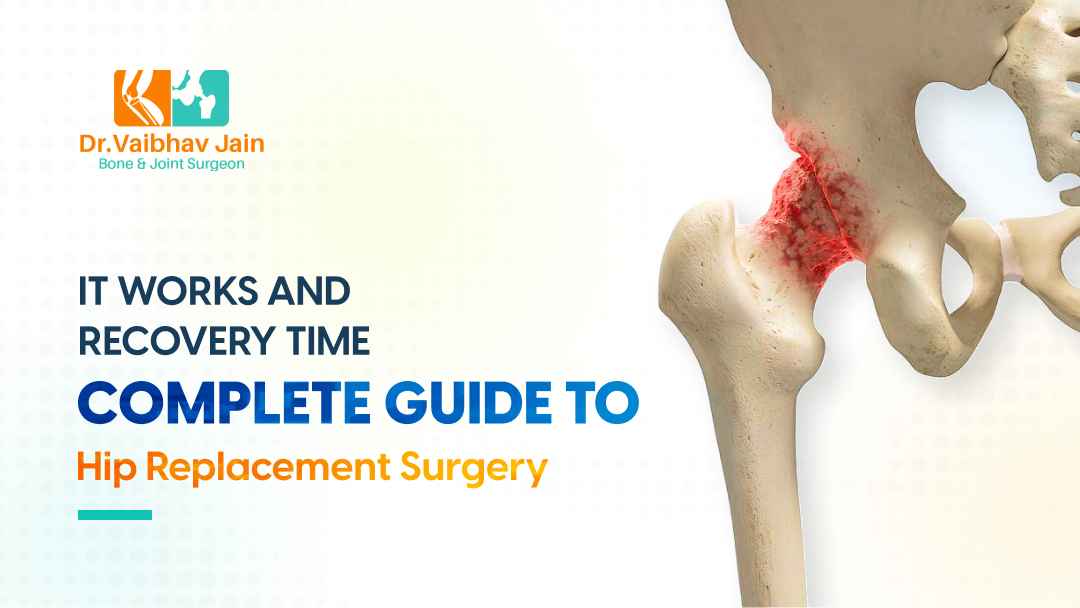Hip replacement surgery is performed when the cartilage around the hip bone of a hip replacement sufferer becomes damaged through arthritis or other causes. The artificial hip is then used to replace the damaged hip joint.
This is incredibly used to treat deformities caused by osteoarthritis. The hip joint is smooth and ball-and-socket shaped. The bones are held together by cartilage and a lubricating fluid. In hip replacement, the damaged bone and cartilage are removed, and the artificial joint is inserted.
This comprehensive guide to hip replacement surgery offers an in-depth look at how the procedure works, what to expect during recovery, and how long it takes to fully recover. Get ready to learn everything you need to know about this life-altering surgery.
How Hip Replacement Surgery Works?
Hip replacement surgery is a major operation that can help alleviate pain and restore mobility for those with severe hip damage or arthritis. In this procedure, a damaged hip joint is replaced with an artificial joint, or prosthesis. The surgery is typically done on an outpatient basis and can often be done arthroscopically with minimal incisions. It is important to understand the different types of Hip joint replacement as well as the necessary preparation and postoperative care.
Types Of Hip Replacement Surgery
There are two main types of hip replacement surgery – total hip replacement (THR) and partial hip replacement (PHR). Total hip replacement is the most common type of hip replacement and involves replacing the entire hip joint with a prosthetic hip joint. Partial hip replacement, on the other hand, involves replacing only the head and neck of the femur with a prosthetic joint.
1. Total Hip Replacement
In total hip replacement surgery, the surgeon will remove the damaged hip joint and replace it with a new artificial joint. The artificial joint is typically made of metal and plastic components, and may also include ceramic components. The new joint is designed to move and function as a normal hip joint.
2. Partial Hip Replacement
Partial hip replacement involves replacing only the head and neck of the femur with a prosthetic joint. This type of surgery is often used for those who have damage to only a portion of the hip joint. Generally, a partial hip replacement is less invasive than a total hip replacement and may allow for a quicker and easier recovery.
Preparation For Surgery
Prior to undergoing hip replacement surgeries, it is important to undergo a full medical evaluation to ensure that you are in good health and an appropriate candidate for surgery. This evaluation will typically include a physical exam and a variety of tests and imaging scans. Additionally, your doctor may recommend lifestyle modifications prior to surgery, such as quitting smoking and losing weight.
Surgical Procedure
During the surgery, the surgeon will make an incision in the hip area to access the hip joint. The damaged hip joint will then be removed, and the new artificial joint will be implanted. The procedure may be performed under general anesthesia or local anesthesia, depending on the patient’s preference and the surgeon’s recommendation.
Postoperative Care
Once the surgery is complete, the patient will typically be monitored in a recovery room. Pain management is a key part of recovery and may involve the use of medications and other treatments. Additionally, physical therapy is often recommended to help the patient regain strength and mobility. Following the postoperative care plan as prescribed by the surgeon is important for a successful recovery.
Hip Replacement Surgery Recovery Time And Tips
| Aspect | Details |
|---|---|
| Recovery Time | It usually takes about 5 to 8 weeks to feel better. |
| Hospital Stay | You may stay in the hospital for 1 to 3 days. |
| Pain Management | You’ll get medicine to help with pain. |
| Physical Therapy | You will do exercises to help you move your hip better. |
| Walking | You can start walking with help soon after surgery. |
| Avoid High Impact | Try not to jump or run for a few months. |
| Follow Doctor’s Advice | Listen to your doctor for the best recovery. |
| Rest and Relax | Get plenty of rest to help your hip heal. |
| Use Assistive Devices | Use crutches or a walker if needed. |
| Checkups | Go to follow-up appointments to check your progress. |
Hip resurfacing is a major procedure that can drastically improve your quality of life. It’s important to know what to expect from the recovery process following your surgery, so that you can plan accordingly and take the necessary steps to ensure a safe and successful recovery.
The recovery period for hip replacement surgery can vary for each individual. It’s important to remember that everyone is different, so it’s best to talk to your doctor about your specific recovery timeline. On average, hip replacement recovery takes two to four weeks, but there are a few factors that can affect your individual recovery time.
The most important factor to take into consideration is your level of physical activity prior to the surgery. The more active you were before the surgery, the quicker your recovery may be. That’s because your muscles and joints are already used to moving and handling physical activity.
Your age, nutrition, and preexisting conditions are also important factors to consider when it comes to your recovery timeline. A younger person may have a quicker recovery period than an older person. Additionally, a well-balanced diet and active lifestyle can reduce recovery time and improve overall health. Lastly, any preexisting health conditions should be discussed with your doctor before undergoing Hip implant surgery.
It’s also important to take into consideration any lifestyle or environmental factors that may affect your hip replacement recovery time. After the surgery, you’ll need to take certain steps to ensure a successful recovery, such as avoiding lifting heavy items and engaging in low-impact activities. It’s also important to get plenty of rest and maintain a healthy diet throughout the entire recovery process.
Hip replacement surgery can be a life-changing experience, and it’s important to understand the recovery timeline before undergoing the procedure. Talk to your doctor about your individual recovery timeline and take the necessary precautions to ensure a successful recovery. With the right lifestyle habits and a positive attitude, you can ensure a successful Artificial hip joint recovery.
Key Takeaways
Hip replacement surgery is a major medical procedure with potential risks and benefits. It is a life-changing surgery with a lengthy recovery time, so it is important to understand how it works and how long recovery may take. With this guide, you can better prepare yourself for the surgery and its aftermath. With a good understanding of the procedure, its risks and its overall recovery time, you can make an informed decision about hip replacement surgery and move forward with confidence.
Are you considering Hip Replacement Surgery? If so, your first step should be to consult with Dr. Vaibhav Jain is an experienced and knowledgeable orthopaedics surgeon who specializes in the diagnosis and treatment of hip problems, including Hip Replacement Surgery.





